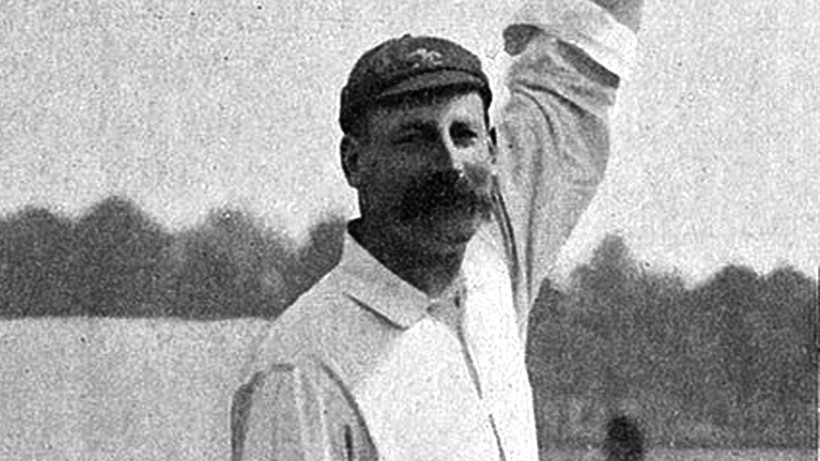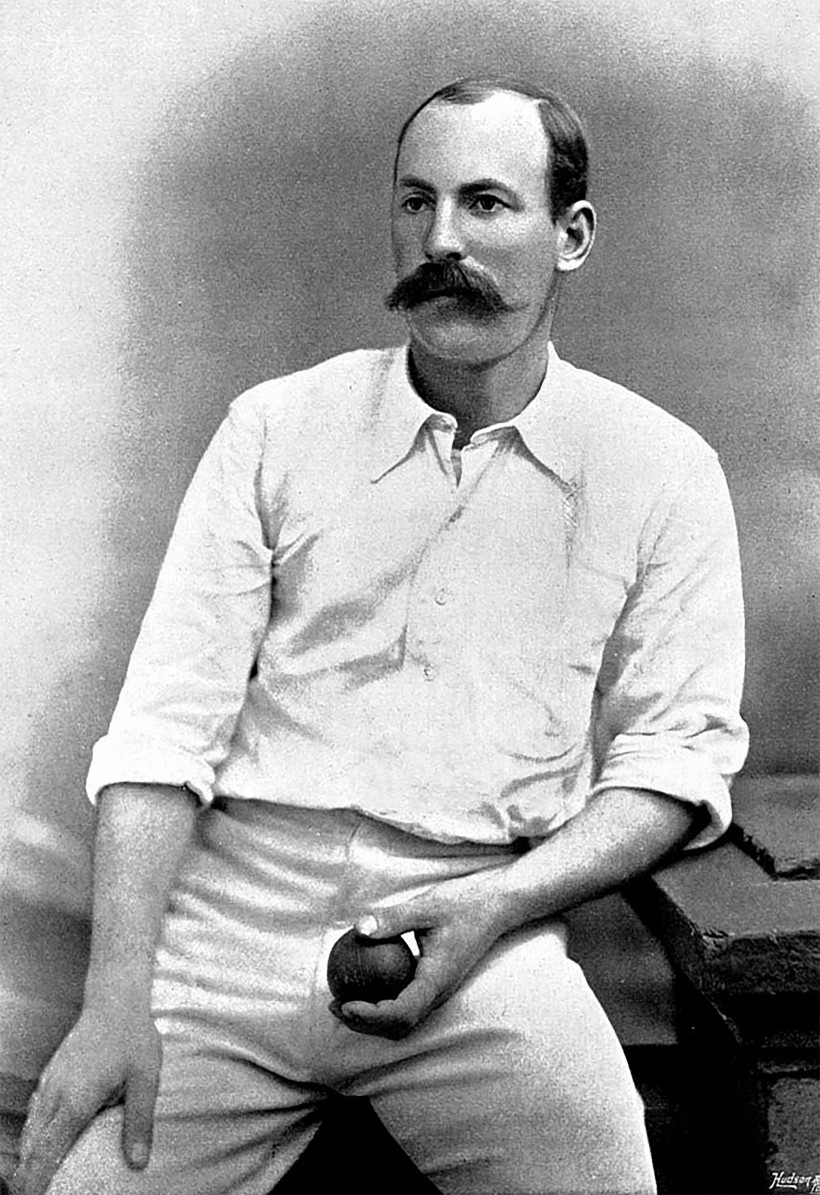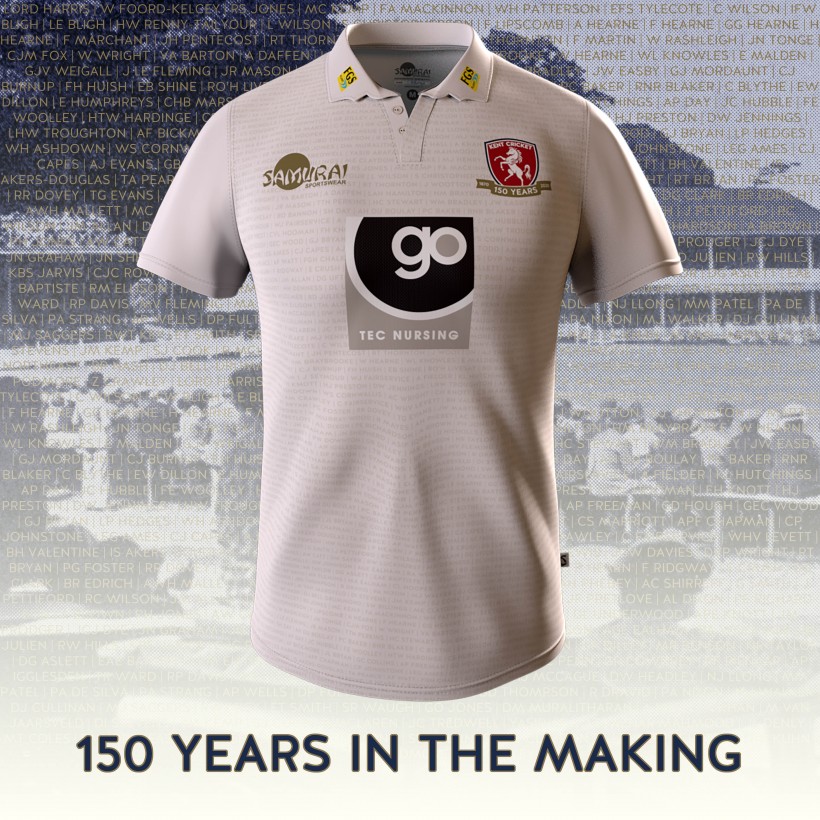‘Nutty’ Martin – Kent’s original left-arm kingpin
Sunday 29th March 2020

Only eight bowlers have taken more wickets for Kent than Fred ‘Nutty’ Martin.
For over a decade widely regarded as one of the best left-arm bowlers in England, he took 947 wickets for Kent, over 1,300 in all first-class cricket. Of the bowlers above him in Kent’s all-time wicket-taking list, only Colin Blythe and ‘Tich’ Freeman took wickets at lower cost.
Frederick ‘Nutty’ Martin is Kent Cricket’s 24th Capped Player >>>
When he was at his peak, England had more left-arm bowlers of quality than could be fitted into one playing XI, but in his first and only Test match against Australia, at The Oval in 1890, Martin had his moment of glory. 12 for 102 and victory for England by two wickets.
In that year, he bowled 1,701 overs and claimed 190 wickets (ave.13.05). In 1892, Wisden made him one of their ‘Five Great Bowlers of the Year’.
In his early days, ‘Nutty’ Martin bowled fast, or, more likely, as fast as he could. According to his own account, he had “fallen into a way of bowling very slow” when he came to Kent. It was on the advice of fellow cricketers George Hearne and Jim Wootton that he switched to medium-pace.
At this distance in time it is impossible to determine whether Martin bowled orthodox finger-spin or cutters, possibly both.
In more recent years we have seen Derek Underwood spin prodigiously at medium-pace and Martin’s method may not have been so very different.
The difficulty is that when Victoria was Queen, writers tended to use the term ‘spin’ to indicate any deviation from straight. Even very fast bowlers were sometimes described as bowling with ‘plenty of spin’.
Frederick Martin was born in Dartford on 12 October 1861 to William and Ann Martin. His father was a ‘labourer in an ironworks,’ and both his grandfathers worked in the industry. Although none of his five brothers and two sisters displayed any interest in cricket, Martin played cricket with other boys on Dartford Brent before moving to the Darenth Vale Club and then to Dartford Albion.
By 1882 his success began to attract notice, and his uncle Arthur Blackman,who had played as an amateur for Surrey, Kent and Sussex, used his contacts with Herbert Knatchbull Hugessen, long term member of the Kent Committee and shortly to be President, to secure a place for his nephew in a forthcoming series of three Colts trial matches due to be played over a period of seven days in May. He did little to impress.
But in 1884 he joined the St Lawrence Club in Canterbury. In his first season there he took over 100 wickets at around nine each, averaged 35 with the bat and hit two centuries. Next season he took 117 wickets, and in July he made an uneventful debut for Kent, v Sussex at Gravesend – 0 and 0 for 1 from one over.
His first three games for Kent in 1886 brought him just two wickets. Recalled to the side at the end of August, he responded with figures of 12 for 86 v Surrey at The Oval, 7 for 77 v Lancashire at Mote Park and 8 for 72 at Trent Bridge. 29 wickets at 10.44 placed him top of the Kent bowling averages.
1887 was disappointing with only 38 wickets, although it was the year he was capped by Kent and also the year he married his wife Esther at Bridge Parish Church.
In 1888, he was paired with another left-armer, Walter Wright, for the first time and for half a dozen seasons these two would be the backbone of the Kent attack, delivering over two thirds of the overs bowled for the County between 1888 and 1891. Three times they bowled unchanged through a match, ten times through a complete innings.
1890 and 1891 were Martin’s best seasons, 190 wickets at 13.05 each in 1890, 105 of them for Kent, 140 at 13.77 in 1891, again 105 for Kent; top of the Kent averages in both seasons. In 1890, apart from his tour de force for England v Australia, he achieved his first hat-trick, and as icing on the seasonal cake, at Gloucester he bowled W.G. Grace before he had scored.
When the team was to be selected for the Oval Test match against Australia in 1890, Lord Hawke, the supreme authority at Yorkshire, in a huff because Andrew Stoddart had opted to play for Middlesex at Bradford rather than for his country, refused to release Bobby Peel. The obvious replacement, Briggs, was injured and so the Surrey executive chose Fred Martin. He had already taken 32 wickets in four matches against the tourists.
With so many Australian wickets already under his belt, Martin can hardly have lacked confidence on his Test debut and rain made conditions ideal for him.
Bowling unchanged with Lohmann, bar six overs, he produced figures of 27-9-50-6 and 30.2-12-52-6.
By the end of the season in seven games against the visitors, two each for Kent, MCC and South of England, one for England, he claimed 56 wickets at 11.51 each.
Seven times he took five in an innings, three times ten in a match and dismissed every member of the touring party (except Harry Boyle the manager who played occasionally) at least once.
Martin was never again picked for a Test match in England. Well as he had performed, this is not so very remarkable.
Peel and Briggs were generally regarded as the best left-arm spinners in the country, both were genuine allrounders and better in the field, Briggs especially so.
Martin did, however, receive one more England cap, albeit retrospectively. He was one of the team taken to South Africa by Walter Read in 1891/92 with an itinerary consisting, with one exception, entirely of matches against odds.
The exception, against ‘An Eleven of South Africa’ at Cape Town, was subsequently upgraded to Test match status. Not called on to bowl in the first innings, Martin bowled unchanged in the second with Gloucestershire’s Australian John Ferris to dismiss the home side for 83 (Ferris 7 for 37, Martin 2 for 39).
In 1896 Kent acquired two amateur fast bowlers, Bill Bradley and Eustace Shine, which took some of the load from the professionals and Martin bowled more than 400 fewer overs than in 1895. Nevertheless, with 101 wickets at 21.15 apiece (79 at 20.48 for Kent) Martin passed the landmark 100 for the sixth and last time.
Although more expensive than usual, on his day he was still a match winner. 1898 proved to be Fred Martin’s penultimate season with Kent. Although no longer likely to run through a good batting side, he was still economical and 73 wickets at 18.98 each (79 in all matches) placed him top of the Kent averages.
Some aspects of Fred Martin’s final season are unclear. According to Wisden he was ‘incapacitated for part of the season’. In fact, he played in every Kent game up to the end of July but in his final match, against Essex at Leyton he bowled only four overs. He missed his own benefit match, v Surrey in Canterbury Week, which in the event finished in two days.
Martin played no more for Kent, but played three first-class matches for MCC in 1900 and remained on the staff at Lord’s until 1908. In 1902 he was accepted on to the umpire’s list and between 1902 and 1906 stood in 50 first-class matches, but never in a Test match.
He did not live to a great age. Despite apparently being in good health, Fred Martin died suddenly from a cerebral haemorrhage on 13 December 1921, in his home town of Dartford.
There remains the question of why Fred Martin was called ‘Nutty’. Martin himself apparently had no idea. The word was of course used to indicate ‘eccentric’ or worse, but Martin was not that type.
In photographs of Martin in civilian clothes, he looks what might have been called a bit ‘flash’. As a variant of ‘natty’, ‘nutty’ was at one time used to indicate ‘smart’ or ‘well turned out’. Perhaps that’s where the name came from.
Fred ‘Nutty’ Martin is Kent Cricket’s 24th Capped Player >>>
Article courtesy of the Kent Cricket Heritage Trust (KCHT). Click here for more information on how to join the KCHT.

The names of all 219 of Kent Cricket’s Capped Players appear on the Club’s commemorative 150th Year first-class playing jersey for the 2020 season.
Order yours now and own a special piece of Kent’s history >>>

